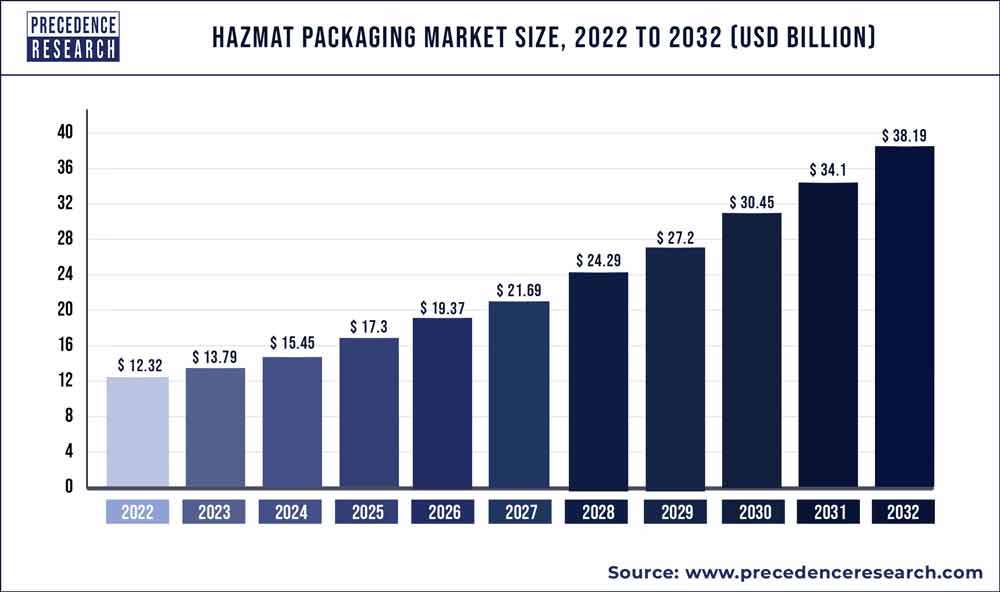The global hazmat packaging market size was estimated at USD 12.32 billion in 2022 and is projected to hit around USD 38.19 billion by 2032, growing at a CAGR of 11.98% from 2023 to 2032.

The Hazmat Packaging market plays a crucial role in ensuring the safe transportation of hazardous materials. These materials, posing risks to health, safety, and the environment, necessitate compliant packaging solutions. In this overview, we delve into key market dynamics, geographical trends, and recent developments shaping the Hazmat Packaging industry.
The Hazmat Packaging market involves the design, manufacturing, and distribution of specialized packaging solutions for the safe transport of hazardous materials. Stringent regulations set by international bodies necessitate compliance, and the market is driven by increasing awareness of hazards, expanding chemical and pharmaceutical industries, and growth in international trade and logistics.
Key Takeaways:
- The Asia Pacific region is poised to lead the global Hazmat Packaging market from 2023 to 2032, driven by the growth in chemical, manufacturing, and pharmaceutical industries.
- North America is projected to hold the largest revenue share in the market from 2023 to 2032, owing to stringent safety regulations and a robust oil and gas sector.
- Hazmat packaging materials, particularly plastics, are expected to record the highest revenue share from 2023 to 2032, offering benefits like chemical resistance and recyclability.
- The chemical segment is anticipated to have the maximum market share in end-use industries between 2023 and 2032, fueled by the growth in chemical, petrochemical, and industrial chemical sectors.
Get a Sample: https://www.precedenceresearch.com/sample/3071
Report Scope of the Hazmat Packaging Market:
| Report Coverage | Details |
| Market Size in 2023 | USD 13.79 Billion |
| Market Size by 2032 | USD 38.19 Billion |
| Growth Rate from 2023 to 2032 | CAGR of 11.98% |
| Base Year | 2022 |
| Forecast Period | 2023 to 2032 |
| Segments Covered | By Product Type, By Material Type, and By End-use |
| Regions Covered | North America, Europe, Asia-Pacific, Latin America, and Middle East & Africa |
Read More: Semiconductor Packaging Market Size to Reach USD 65.46 Bn By 2032
Hazmat Packaging Market Dynamics
Driver
The increasing stringency of regulations imposed by organizations such as the International Air Transport Association (IATA), the International Maritime Organization (IMO), and the Department of Transportation (DOT) plays a pivotal role in propelling the demand for specialized hazardous materials (hazmat) packaging. These regulations are designed to ensure the safe handling and transportation of hazardous materials, compelling industries to adopt packaging solutions that comply with the specified safety standards. The growing emphasis on adherence to these regulations acts as a driving force behind the need for specialized packaging in the hazmat industry.
Restraint
While the surge in regulations acts as a driving force, it simultaneously imposes a set of challenges on businesses involved in hazmat packaging. The complexity and strictness of these regulations can become a significant restraint. Achieving and maintaining compliance requires substantial investments in various aspects, such as employee training, certifications, and comprehensive documentation. The financial burden associated with meeting these stringent compliance requirements becomes a significant restraint for businesses operating in the hazmat packaging sector. The cost implications can be substantial, impacting the overall profitability and competitiveness of companies in this industry.
Opportunity
